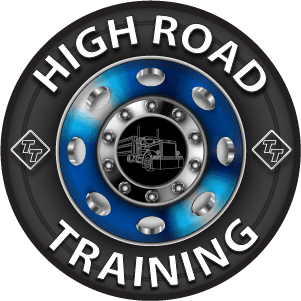Note: Your are not logged in. We can not keep your scores or track your progress unless you Register and Log In
5.3 – Inspecting Air Brake Systems
You should use the basic seven-step inspection procedure described in Section 2 to inspect your vehicle. There are more items to inspect on a vehicle with air brakes than one without them. These items are discussed below, in the order they fit into the seven-step method.
5.3.1 – During Step 2 Engine Compartment Checks
Check Air Compressor Drive Belt (if compressor is belt-driven). If the air compressor is belt-driven, check the condition and tightness of the belt. It should be in good condition.
5.3.2 – During Step 5 Walk-around Inspection
Check Slack Adjusters on S-cam Brakes. Park on level ground and chock the wheels to prevent the vehicle from moving. Release the parking brakes so you can move the slack adjusters. Use gloves and pull hard on each slack adjuster that you can reach. If a slack adjuster moves more than about 1 inch where the push rod attaches to it, it probably needs adjustment. Adjust it or have it adjusted. Vehicles with too much brake slack can be very hard to stop. Out-of-adjustment brakes are the most common problem found in roadside inspections. Be safe. Check the slack adjusters.
All vehicles built since 1994 have automatic slack adjusters. Even though automatic slack adjustors adjust themselves during full brake applications, they must be checked. Automatic adjusters should not have to be manually adjusted except when performing maintenance on the brakes and during installation of the slack adjusters. In a vehicle equipped with automatic adjusters, when the pushrod stroke exceeds the legal brake adjustment limit, it is an indication that a mechanical problem exists in the adjuster itself, a problem with the related foundation brake components, or that the adjuster was improperly installed.
The manual adjustment of an automatic adjuster to bring a brake pushrod stroke within legal limits is generally masking a mechanical problem and is not fixing it. Further routine adjustment of most automatic adjusters will likely result in premature wear of the adjuster itself. It is recommended that when brakes equipped with automatic adjusters are found to be out of adjustment, drivers take the vehicle to a repair facility as soon as possible to have the problem corrected. The manual adjustment of automatic slack adjusters is dangerous because it may give the driver a false sense of security regarding the effectiveness of the braking system.
The manual adjustment of an automatic adjuster should only be used as a temporary measure to correct the adjustment in an emergency situation as it is likely the brake will soon be back out of adjustment since this procedure usually does not fix the underlying adjustment problem.
(Note: Automatic slack adjusters are made by different manufacturers and do not all operate the same. Therefore, the specific manufacturer’s service manual should be consulted prior to troubleshooting a brake adjustment problem.)
Check Brake Drums (or Discs), Linings and Hoses. Brake drums (or discs) must not have cracks longer than one-half the width of the friction area. Linings (friction material) must not be loose or soaked with oil or grease. They must not be dangerously thin. Mechanical parts must be in place, not broken or missing. Check the air hoses connected to the brake chambers to make sure they are not cut or worn due to rubbing.
Multiple-Choice Questions:
A slack adjuster probably needs adjustment if it moves more than how much?
- About 3 inches
- More than 4 inches
- About 1 inch
- 6 inches
Brake drums (or discs) must not have cracks longer than:
- None of these answers are correct
- One-half the width of the friction area
- Twice the width of the friction area
- The width of the friction area
Which of the following are true about automatic slack adjusters?
- Even though automatic slack adjustors adjust themselves during full brake applications, they must be checked
- It is recommended that when brakes equipped with automatic adjusters are found to be out of adjustment, drivers take the vehicle to a repair facility as soon as possible to have the problem corrected.
- Automatic adjusters should not have to be manually adjusted except when performing maintenance on the brakes and during installation of the slack adjusters
- All these are true
What is the most common problem found on roadside inspections?
- Flat tire
- Air leaks
- Steering off-center
- Out-of-adjustment brakes
Complete!
You can Return To The Table Of Contents







 TT On Facebook
TT On Facebook